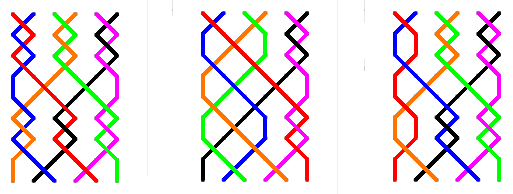Successful dodging
What is a dodge?
A dodge occurs when a bell which is hunting takes a step backwards and then continues to hunt in the original direction.

The diagram shows the line of two bells dodging. The bell represented by the blue line is ringing a dodge while hunting down. This is known as a down dodge. The bell represented by the red line is ringing a dodge while hunting up. This is known as an up dodge.
Practising dodging
You can practise dodging using specific kaleidoscope ringing exercises or by ringing Treble Bob Hunt. Both concentrate the dodges into a small number of changes giving you plenty of practice and ropesight is simplified.
Bell control and striking in the right place whilst dodging
To dodge successfully you need to be able to change the speed of your ringing at both handstroke and backstroke. At first your teacher will tell you when to ring quicker or slower to strike your bell in the right place. However you will quickly be expected to do this yourself by using your listening skills.
When dodging 3/4 down you hunt down from the back – all the blows are quick blows with the exception of one:
- A quick blow at backstroke down in to 4th place
- A quick blow at handstroke down to 3rd place – put a little more weight on the rope
- A slow blow back up to 4th place at backstroke – put a little less weight on the rope
- A quick blow down into 3rd place at handstroke
- Then continue with the quicker blows to the lead
When dodging 3/4 up you hunt up from the lead – all the blows are slow blows with the exception of one:
- A slow blow up into 2nd place at handstroke
- A slow blow up to 3rd place at backstroke
- A slow blow up to 4th place at handstroke – put a little less weight on the rope
- A quick blow down into 3rd place at backstroke – put a little more weight on the rope
- A slow blow up to 4th place at handstroke
- Then continue to hunt up to the back
Ropesight whilst dodging
Good ropesight whilst dodging takes time to develop. The first step is recognising which bell you are dodging with. You will always strike over this bell twice – at handstroke when dodging up and at backstroke when dodging down.

It is harder to see which bell you are striking over on the other stroke as this depends on the work that the other bell is doing [see above]. If you are finding this difficult study the method being rung by the other bells and learn what the pattern is. Eventually you will be able to see the bells without doing this.